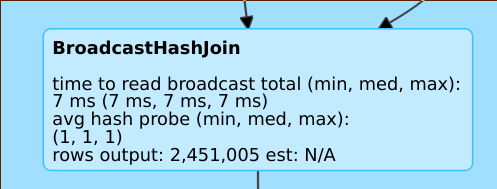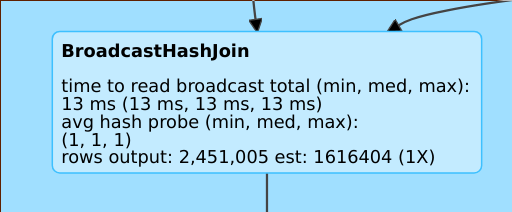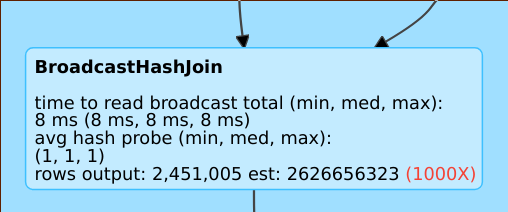Cost-based optimizer
Spark SQL can use a cost-based optimizer (CBO) to improve query plans. This is especially useful for queries with multiple joins. For this to work it is critical to collect table and column statistics and keep them up to date.
Collect statistics
To get the full benefit of the CBO it is important to collect both column statistics and table statistics. You can use the ANALYZE TABLE command to manually collect statistics.
Tip
To keep the statistics up-to-date, run ANALYZE TABLE after writing to the table.
Use ANALYZE
Predictive optimization automatically runs ANALYZE, a command for collecting statistics, on Unity Catalog managed tables. Databricks recommends enabling predictive optimization for all Unity Catalog managed tables to simplify data maintenance and reduce storage costs. See ANALYZE TABLE.
Verify query plans
There are several ways to verify the query plan.
EXPLAIN command
To check if the plan uses statistics, use the SQL commands
- Databricks Runtime 7.x and above: EXPLAIN
If statistics are missing then the query plan might not be optimal.
== Optimized Logical Plan ==
Aggregate [s_store_sk], [s_store_sk, count(1) AS count(1)L], Statistics(sizeInBytes=20.0 B, rowCount=1, hints=none)
+- Project [s_store_sk], Statistics(sizeInBytes=18.5 MB, rowCount=1.62E+6, hints=none)
+- Join Inner, (d_date_sk = ss_sold_date_sk), Statistics(sizeInBytes=30.8 MB, rowCount=1.62E+6, hints=none)
:- Project [ss_sold_date_sk, s_store_sk], Statistics(sizeInBytes=39.1 GB, rowCount=2.63E+9, hints=none)
: +- Join Inner, (s_store_sk = ss_store_sk), Statistics(sizeInBytes=48.9 GB, rowCount=2.63E+9, hints=none)
: :- Project [ss_store_sk, ss_sold_date_sk], Statistics(sizeInBytes=39.1 GB, rowCount=2.63E+9, hints=none)
: : +- Filter (isnotnull(ss_store_sk) && isnotnull(ss_sold_date_sk)), Statistics(sizeInBytes=39.1 GB, rowCount=2.63E+9, hints=none)
: : +- Relation[ss_store_sk,ss_sold_date_sk] parquet, Statistics(sizeInBytes=134.6 GB, rowCount=2.88E+9, hints=none)
: +- Project [s_store_sk], Statistics(sizeInBytes=11.7 KB, rowCount=1.00E+3, hints=none)
: +- Filter isnotnull(s_store_sk), Statistics(sizeInBytes=11.7 KB, rowCount=1.00E+3, hints=none)
: +- Relation[s_store_sk] parquet, Statistics(sizeInBytes=88.0 KB, rowCount=1.00E+3, hints=none)
+- Project [d_date_sk], Statistics(sizeInBytes=12.0 B, rowCount=1, hints=none)
+- Filter ((((isnotnull(d_year) && isnotnull(d_date)) && (d_year = 2000)) && (d_date = 2000-12-31)) && isnotnull(d_date_sk)), Statistics(sizeInBytes=38.0 B, rowCount=1, hints=none)
+- Relation[d_date_sk,d_date,d_year] parquet, Statistics(sizeInBytes=1786.7 KB, rowCount=7.30E+4, hints=none)
Important
The rowCount statistic is especially important for queries with multiple joins. If rowCount is missing, it means there is not enough information to calculate it (that is, some required columns do not have statistics).
Spark SQL UI
Use the Spark SQL UI page to see the executed plan and accuracy of the statistics.

A line such as rows output: 2,451,005 est: N/A means that this operator produces approximately 2M rows and there were no statistics available.

A line such as rows output: 2,451,005 est: 1616404 (1X) means that this operator produces approx. 2M rows, while the estimate was approx. 1.6M and the estimation error factor was 1.

A line such as rows output: 2,451,005 est: 2626656323 means that this operator produces approximately 2M rows while the estimate was 2B rows, so the estimation error factor was 1000.
Disable the Cost-Based Optimizer
The CBO is enabled by default. You disable the CBO by changing the spark.sql.cbo.enabled flag.
spark.conf.set("spark.sql.cbo.enabled", false)